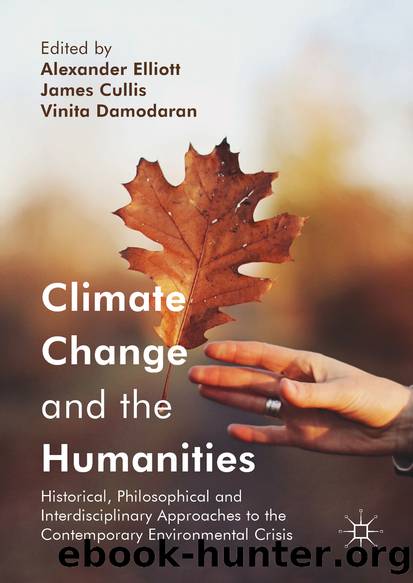Climate Change and the Humanities by Alexander Elliott James Cullis & Vinita Damodaran

Author:Alexander Elliott, James Cullis & Vinita Damodaran
Language: eng
Format: epub
Publisher: Palgrave Macmillan UK, London
Cattle and mountains were just so much rustic detail, and of course the ideal number of rural labourers in a picturesque scene was no labourers at all. Gilpin certainly knew that the countryside was full of people going about their business. He even encountered groups of labourers in Cumbria on one of the yearâs rent days, and admits âwe were not a little entertained by the simplicity, and variety of the several groups and figures we metâ. But they had no place in picturesque art: âIn grand scenes, even the peasant cannot be admitted, if he be employed in the low occupations of his profession: the spade, the scythe, and the rake are all excludedâ. What was allowed was pastoral idleness: âthe lazy cowherd resting on his pole ⦠the peasant lolling on a rockâ, an angler rather than a fisherman, and gypsies, banditti, and the occasional individual soldier in antique armour. 36 The image of the countryside presented therefore looked very much in need of improvementâslack, inefficient, indigent, lawless, and archaic. Moreover, once âimprovedâ the landscape was likely to be as empty of agricultural labour as the picturesque depicted it since nearly all the peasantry would have been forced off the land. 37 The emergence of the picturesque as the enclosure of common land began to accelerate is surely no coincidence. The picturesque was not so much an expression of nostalgia for old, pre-agrarian country life before the Industrial Revolution as an exoneration of the forces of agricultural change that were pauperizing hundreds of thousands of rural labourers.
But for all its dreadful and artful contrivance, the picturesque did not disappear. Throughout the nineteenth century, guidebooks advised that the Lake District was best experienced âduring the wet months, when clouds, mists, and moving vapours gave the landscape a luminous softness most like a wash drawing or an aquatintâ. 38 Valuing a season simply for the range of aesthetic effects with which it is associated rather than for the social and agricultural benefits it brings will either turn the starving rural poor into an artistic spectacle of light, colour, and shade, or simply leave them out of the picture altogether. Both were (and are today) morally unacceptable.
But the cult of the picturesque spread like a weed beyond painting and tourism to shape the practices of English gardening. 39 Pastoral poetry and picturesque painting drained history, tradition, and folklore from the representation of the countryside through a disengaged sentimentality, and English landscape gardening performed the same operation at ground levelâwith the same result: labour and indeed nature were comprehensively effaced from the horticultural scene. William Masonâs commentary on the third book of his poem The English Garden (1783) was quite explicit on this point:As we have all along considered the Garden as a Picture, so we are under the necessity of considering the unadorned and naked soil as the Painterâs canvas, and, consequently, of looking on every means of ornament as the pencils and colours with which he is to work.
Download
This site does not store any files on its server. We only index and link to content provided by other sites. Please contact the content providers to delete copyright contents if any and email us, we'll remove relevant links or contents immediately.
Man-made Catastrophes and Risk Information Concealment by Dmitry Chernov & Didier Sornette(5653)
The Revenge of Geography: What the Map Tells Us About Coming Conflicts and the Battle Against Fate by Kaplan Robert D(3962)
Zero Waste Home by Bea Johnson(3656)
In a Sunburned Country by Bill Bryson(3369)
COSMOS by Carl Sagan(3350)
Good by S. Walden(3347)
The Fate of Rome: Climate, Disease, and the End of an Empire (The Princeton History of the Ancient World) by Kyle Harper(2875)
Camino Island by John Grisham(2721)
A Wilder Time by William E. Glassley(2690)
Organic Mushroom Farming and Mycoremediation by Tradd Cotter(2567)
The Ogre by Doug Scott(2503)
Human Dynamics Research in Smart and Connected Communities by Shih-Lung Shaw & Daniel Sui(2431)
Energy Myths and Realities by Vaclav Smil(2381)
The Traveler's Gift by Andy Andrews(2300)
9781803241661-PYTHON FOR ARCGIS PRO by Unknown(2271)
Inside the Middle East by Avi Melamed(2232)
Birds of New Guinea by Pratt Thane K.; Beehler Bruce M.; Anderton John C(2175)
A History of Warfare by John Keegan(2106)
Ultimate Navigation Manual by Lyle Brotherton(2050)
